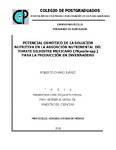| dc.description.abstract | El tomate silvestre mexicano (Physalis spp.) es un acervo genético con alto potencial alimentario, económico y terapéutico para zonas rurales de nuestro país. Además, se utiliza como fuente de germoplasma para programas de mejoramiento genético. Sin embargo, no ha sido estudiado respecto a su demanda nutrimental para que cumpla con los estándares de calidad que exige el mercado. El objetivo de la presente investigación fue evaluar la producción hidropónica del tomate silvestre mexicano, expuesto a los potenciales osmóticos de -0.018, -0.036 y -0.054 MPa en la solución nutritiva, con relación a su crecimiento, fisiología, concentración nutrimental de la hoja, rendimiento y calidad de fruto. Para ello, se establecieron dos experimentos. El primero se realizó de marzo a septiembre y el segundo de junio a octubre de 2017. En el primer estudio se evaluaron los materiales silvestres pertenecientes al Banco Nacional de Germoplasma de Especies Nativas de la Universidad Autónoma Chapingo (BNGEN): accesiones 9b (170 BNGEN), 17b (48 BNGEN) y 7b (167 BNGEN) y el material silvestre Filadelfia, originario de la región de la Tierra Caliente del estado de Guerrero. En el primer experimento, las plantas crecieron sin problema con la solución nutritiva cuyo potencial osmótico (Ѱo) fue de -0.036 MPa, ya que al ser expuestas a un Ѱo de -0.054 MPa, la producción de frutos disminuyó. También se observó que el material 9b presentó el mayor número y peso de frutos. En el segundo experimento se evaluaron los materiales 9b y Filadelfia por presentar una mayor producción en el primer estudio y se encontró que en las variables de crecimiento y fisiológicas, con un Ѱo de -0.036 MPa, aumentó la altura de planta y el número de flores. Sin embargo, con un Ѱo de -0.054 MPa, se incrementó el diámetro de tallo, el número de bifurcaciones, las lecturas SPAD, el índice normalizado de vegetación (INV) y el área foliar, y con un Ѱo de -0.018 MPa, la tasa de asimilación de CO2 fue mayor, y el material 9b, aumentó el número de bifurcaciones, las lecturas SPAD y la asimilación de CO2, y Filadelfia sólo incrementó el área foliar. En el estado nutrimental, con un Ѱo de -0.036 MPa la concentración de K aumentó y el B y Zn con un Ѱo de -0.036 MPa, pero el Cu con uno de -0.054 MPa. Con el material 9b se incrementó la concentración de Mn y Zn y en Filadelfia el de Fe. La producción de materia seca aumentó cuando la solución nutritiva estaba más concentrada. Sin embargo, el peso del vástago y peso total, en la etapa vegetativa y de floración, aumentó con un Ѱo de -0.036 y -0.054 MPa. El material silvestre 9b incrementó el peso el peso se del vástago y el peso seco total en la etapa vegetativa y de floración. En calidad de fruto, sólo se afectó el pH del jugo, ya que éste aumentó al regar las plantas con una solución nutritiva con un Ѱo de -0.036 MPa. _______________ OSMOTIC POTENTIAL OF THE NUTRIENT SOLUTION IN THE NUTRIMENTAL ABSORPTION OF MEXICAN WILD TOMATO (Physalis spp.) FOR GREENHOUSE PRODUCTION. ABSTRACT: The mexican wild tomato (Physalis spp.) is a gene pool with high potential for agroindustry, economical and therapeutically for rural areas of Mexico. In addition, it can be used as a source of germplasm for breeding programs. However, it has not been studied regarding its nutrient demand in order to comply with quality standards demanded by the market. The objective of this research was to evaluate hydroponic production of wild tomato, exposed to osmotic potentials -0.018, -0.036, and -0.054 MPa in the nutrient solution, in relation to its growth, physiology, nutrient concentration on leaf, yield and quality of fruit. For this purpose, two experiments were established. The first was carried out from March to September and the second from June to October of 2017. In the first study wild materials belonging to the National Bank of germplasm of native species of the Autonomous University of Chapingo (BNGEN) were evaluated: accessions 9b (170 BNGEN), 17b (48 BNGEN) and 7b (167 BNGEN) and wild material Filadelfia, collected from the region of the “Tierra Caliente”, in the State of Guerrero. In the first experiment, the plants grew without a problem with the nutrient solution with osmotic potential (Ѱo) of -0.036 MPa, but when plants were exposed to a Ѱo -0.054 MPa, fruit production decreased. Also, it was observed that the 9b material presented the higher number and weight of fruit. In the second experiment materials, 9b and Philadelphia were evaluated since these outstand. It was found that plant height and number of flowers increased with - 0.036 MPa. However, with -0.054 MPa increased the diameter of stem, number of branches, SPAD readings, normalized vegetation index (INV) and leaf area, and with -0.018 MPa CO2 assimilation rate was higher, 9b material, increased the number of bifurcations, the SPAD readings and the assimilation of CO2, and Philadelphia only increased leaf area. In the nutrient status, with - 0.036 MPa K concentration increased, and B and Zn with a -0.036 MPa, but Cu with - 0.054 MPa. 9b material increased its concentration of Mn and Zn, and Philadelphia of Fe. Dry matter production increased when the nutrient solution was more concentrated (by decreasing the Ѱo); however, shoot and total weight, in the vegetative stage and flowering rose with -0.036 and -0.054 MPa. Accession 9b increased the shoot weight and total dry matter in vegetative stage and flowering. In fruit quality, only was affected the pH of the juice, since this increased by supplying plants with a nutrient solution with -0.036 MPa. | es_MX |


